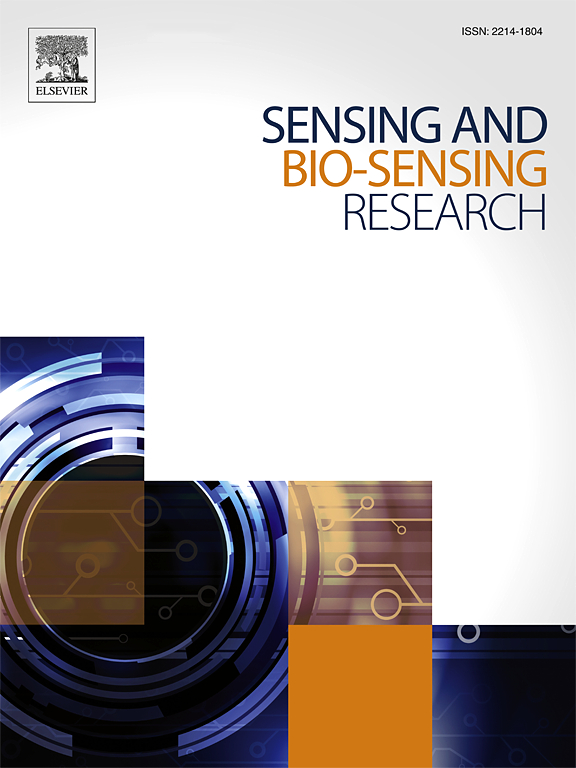Electrochemical aptasensor for ultrasensitive detection of glycated hemoglobin (HbA1c) using gold-modified SPCE
IF 5.4
Q1 CHEMISTRY, ANALYTICAL
引用次数: 0
Abstract
Accurate monitoring of diabetes mellitus (DM) biomarkers, particularly glycated hemoglobin (HbA1c), is essential for assessing long-term blood glucose control, optimizing therapeutic strategies, and preventing diabetes-related complications. To enhance the efficiency of this monitoring, electrochemical aptasensors based on screen-printed carbon electrodes (SPCE) modified with gold nanoparticles (AuNP) have been developed. The results demonstrate that the electrodeposition technique produces a uniform AuNP distribution and significantly increases the current responses of K₃[Fe(CN)₆] compared to bare SPCE. Aptamer immobilization using a streptavidin-biotin system via linker-mediated attachment exhibits high affinity for HbA1c, as evidenced by a significant decrease in current upon target binding.The analytical performance of the aptasensor shows a low detection limit of 8.34 pg/mL, with a linear detection range of 1 to 104 pg/mL. Moreover, the aptasensor exhibits good selectivity for HbA1c over hemoglobin, glucose, and palmitic acid, with a selectivity value of 82.56 %. Stability tests indicate that the sensor retains 90.38 % of its activity after 70 days of storage, confirming its reliability for HbA1c detection. This study contributes to the advancement of effective electrochemical biosensors for diabetes monitoring, enabling early diagnosis and improved disease management.

金修饰SPCE超灵敏检测糖化血红蛋白(HbA1c)的电化学适体传感器
准确监测糖尿病(DM)生物标志物,特别是糖化血红蛋白(HbA1c),对于评估长期血糖控制、优化治疗策略和预防糖尿病相关并发症至关重要。为了提高这种监测的效率,基于纳米金修饰的丝网印刷碳电极(SPCE)的电化学适体传感器已经被开发出来。结果表明,与裸SPCE相比,电沉积技术产生了均匀的AuNP分布,并显著提高了K₃[Fe(CN)₆]的电流响应。链亲和素-生物素系统通过连接体介导的附着固定适体,对HbA1c具有高亲和力,目标结合时电流显著降低。该传感器的检测限为8.34 pg/mL,线性范围为1 ~ 104 pg/mL。此外,该适体传感器对糖化血红蛋白、葡萄糖和棕榈酸具有良好的选择性,选择性值为82.56%。稳定性测试表明,该传感器在储存70天后仍保持90.38%的活性,证实了其检测糖化血红蛋白的可靠性。该研究有助于推进有效的电化学生物传感器用于糖尿病监测,实现早期诊断和改善疾病管理。
本文章由计算机程序翻译,如有差异,请以英文原文为准。
求助全文
约1分钟内获得全文
求助全文
来源期刊

Sensing and Bio-Sensing Research
Engineering-Electrical and Electronic Engineering
CiteScore
10.70
自引率
3.80%
发文量
68
审稿时长
87 days
期刊介绍:
Sensing and Bio-Sensing Research is an open access journal dedicated to the research, design, development, and application of bio-sensing and sensing technologies. The editors will accept research papers, reviews, field trials, and validation studies that are of significant relevance. These submissions should describe new concepts, enhance understanding of the field, or offer insights into the practical application, manufacturing, and commercialization of bio-sensing and sensing technologies.
The journal covers a wide range of topics, including sensing principles and mechanisms, new materials development for transducers and recognition components, fabrication technology, and various types of sensors such as optical, electrochemical, mass-sensitive, gas, biosensors, and more. It also includes environmental, process control, and biomedical applications, signal processing, chemometrics, optoelectronic, mechanical, thermal, and magnetic sensors, as well as interface electronics. Additionally, it covers sensor systems and applications, µTAS (Micro Total Analysis Systems), development of solid-state devices for transducing physical signals, and analytical devices incorporating biological materials.
 求助内容:
求助内容: 应助结果提醒方式:
应助结果提醒方式:


